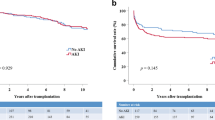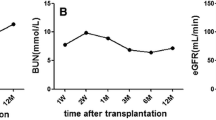Abstract
Background
Whether organs from donors after brain death (DBD) with acute kidney injury (AKI) should be accepted for transplantation is still a matter of debate.
Methods
This was a retrospective, center-based, matched cohort study of 33 renal transplant patients who received a renal allograft from a DBD with AKI. Sixty-five kidney transplants without donor AKI transplanted directly before and after the index transplantation served as controls.
Results
All AKI donors were classified according to RIFLE criteria: 9.1 % Risk, 54.6 % Injury, and 36.4 % Failure. Mean serum creatinine was 2.41 ± 0.88 mg/dL at procurement and 1.06 ± 0.32 mg/dL on admission. AKI donors had lower 24-h urine production (3.22 ± 1.95 vs. 4.59 ± 2.53 L, p = 0.009) and received more frequently noradrenaline (93.9 vs. 72.3 %, p = 0.02) and/or adrenaline (15.2 vs. 1.5 %, p = 0.02). Recipient and transplant characteristics were similar except a more favorable HLA match in control patients (p = 0.01). Hemodialysis posttransplant was more frequently used in AKI recipients (14/33 [42.4 %] vs. 18/65 [27.7 %], p = 0.17). While significant elevations in serum creatinine were noted in these patients until 10 days after transplantation, this difference lost statistical significance by day 14. One-year graft survival was very similar when comparing the groups (93.6 % [95 % CI 76.8–98.4 %] vs. 90.3 % [95 % CI 79.6–95.5 %], log rank p = 0.58).
Conclusions
Kidneys from AKI donors can be transplanted with excellent intermediate prognosis and should not be discarded.

Similar content being viewed by others
References
Ugarte R, Kraus E, Montgomery RA et al (2005) Excellent outcomes after transplantation of deceased donor kidneys with high terminal creatinine and mild pathologic lesions. Transplantation 80:794–800
Kumar MSA, Khan SM, Jaglan S et al (2006) Successful transplantation of kidneys from deceased donors with acute renal failure: three-year results. Transplantation 82:1640–1645
Morgan C, Martin A, Shapiro R et al (2007) Outcomes after transplantation of deceased-donor kidneys with rising serum creatinine. Am J Transpl 7:1288–1292
Greenstein SM, Moore N, McDonough P et al (2008) Excellent outcome using “impaired” standard criteria donors with elevated serum creatinine. Clin Transpl 22:630–633
Kayler LK, Garzon P, Magliocca J et al (2009) Outcomes and utilization of kidneys from deceased donors with acute kidney injury. Am J Transpl 9:367–373
Zuckerman JM, Singh RP, Farney AC et al (2009) Single center experience transplanting kidneys from deceased donors with terminal acute renal failure. Surgery 146:686–695
Mekeel KL, Moss AA, Mulligan DC et al (2009) Deceased donor kidney transplantation from donors with acute renal failure due to rhabdomyolysis. Am J Transpl 9:1666–1670
Deroure B, Kamar N, Depreneuf H et al (2010) Expanding the criteria of renal kidneys for transplantation: use of donors with acute renal failure. Nephrol Dial Transpl 25:1980–1986
Rodrigo E, Minambres E, Pinera C et al (2010) Using RIFLE criteria to evaluate acute kidney injury in brain-deceased kidney donors. Nephrol Dial Transpl 25:1531–5137
Kolonko A, Chudek J, Pawlik A et al (2011) Acute kidney injury before organ procurement is associated with worse long-term kidney graft outcome. Transpl proc 43:2871–2874
Kim JM, Kim SJ, Kwon CHD et al (2011) Kidneys from deceased donors with oliguria are feasible for kidney transplantation. Transpl Proc 43:2355–2358
Farney AC, Rogers J, Orlando G et al (2013) Evolving experience using kidneys from deceased donors with terminal acute kidney injury. J Am Coll Surg 216:645–656
Klein R, Galante NZ, de Sandes-Freitas TV et al (2013) Transplantation with kidneys retrieved from deceased donors with acute renal failure. Transplantation 95:611–616
Leyking S, Poppleton A, Sester U et al (2014) Kidney transplantation from a deceased donor with anuric acute kidney function caused by rhabdomyolysis. Transplantation 98:e87–e88
Jacobi J, Rebhan D, Heller K et al (2014) Donor acute kidney injury and short-term graft outcome in renal transplantation. Clin Transpl 28:1131–1141
Yuan XP, Han M, Wang XP et al (2014) Kidney transplantation from cardiac death donors with terminal acute renal failure. Transpl Proc 46:1057–1060
Lee MH, Jeong E-G, Chang JY et al (2014) Clinical outcome of kidney transplantation from deceased donors with acute kidney injury network criteria. J Crit Care 29:432–437
Hall IE, Schröppel B, Doshi MD et al (2015) Associations of deceased donor kidney injury with kidney discard and function after transplantation. Am J Transpl 15:1623–1631
Heilman RL, Smith ML, Kurian SM et al (2015) Transplanting kidneys from deceased donors with severe acute kidney injury. Am J Transpl 15:2143–2151
Bellomo R, Ronco C, Kellum JA et al (2004) Acute renal failure—definition, outcome measures, animal models, fluid therapy and information technology needs: the Second International Consensus Conference of the Acute Dialysis Quality Initiative (ADQI) Group. Crit Care 8:R204–R212
Acknowledgments
The results of the present study have been reported in abstract form at the 2012 TTS meeting (Benck U, et al. Excellent intermediate-term results after renal transplantation from brain-dead donors with acute kidney injury, Transplantation 94, 2366, 2012).
Author contributions
The present research has been designed by U.B., P.S., R.B., and B.K.K., statistical analysis has been done by U.B., P.S., and W.H.S., and the first draft of the paper has been prepared by B.K.K. All authors contributed to the conception/design of the work, to acquisition of data and/or analysis of data, to interpretation of data, and to writing or revising of the work, provided important intellectual content, finally approved and are accountable for the work.
Author information
Authors and Affiliations
Corresponding authors
Ethics declarations
Conflict of interest
All authors declare no conflict of interest with regard to the present manuscript.
Rights and permissions
About this article
Cite this article
Benck, U., Schnuelle, P., Krüger, B. et al. Excellent graft and patient survival after renal transplantation from donors after brain death with acute kidney injury: a case–control study. Int Urol Nephrol 47, 2039–2046 (2015). https://doi.org/10.1007/s11255-015-1127-5
Received:
Accepted:
Published:
Issue Date:
DOI: https://doi.org/10.1007/s11255-015-1127-5




